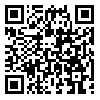Volume 24, Issue 1 (2024)
MCEJ 2024, 24(1): 141-150 |
Back to browse issues page
Download citation:
BibTeX | RIS | EndNote | Medlars | ProCite | Reference Manager | RefWorks
Send citation to:



BibTeX | RIS | EndNote | Medlars | ProCite | Reference Manager | RefWorks
Send citation to:
Seifollahi Teimoorloui A, Jalaly M, Habibnejad Korayem A. An Investigation Into the Physical and Mechanical Properties of Cement Paste Reinforced by TiO2–GO Nanocomposite. MCEJ 2024; 24 (1) :141-150
URL: http://mcej.modares.ac.ir/article-16-70932-en.html
URL: http://mcej.modares.ac.ir/article-16-70932-en.html
1- Iran University of Science and Technology
2- Iran University of Science and Technology ,maisam_jalaly@iust.ac.ir
2- Iran University of Science and Technology ,
Abstract: (1909 Views)
Portland cement is a crucial mineral chemical that is globally produced in large quantities. It has been reported that in 2011, approximately 3.6 billion tons of Portland cement were produced, and its demand continues to grow. However, this industry's expansion has resulted in increased environmental risks. Therefore, it is important to conduct research to enhance the sustainability of this product. The utilization of nanomaterials in cement and concrete materials has received significant attention in recent years. Employing nanotechnology to modify cement-based materials can significantly enhance the efficacy of this inorganic binder. Primarily, nanoparticles possess the capability to fill the porosity within the cement structure and exhibit pozzolanic properties that reinforce concrete. Additionally, the high specific surface area of nanomaterials facilitates increased reactivity at the nanoscale, thereby enhancing cement hydration and subsequently improving its mechanical properties.
Despite cement and concrete being known for their strength, they are also inherently brittle, which hinders their mechanical performance. In recent years, various nanomaterials have been utilized to address this weakness due to their high specific surface area and strengthening capability in different matrices, including cement. This study aims to evaluate the impact of incorporating a binary nanocomposite of titanium dioxide nanoparticles and graphene oxide to enhance the mechanical properties of the Portland cement.
For hybridization, electrostatic adsorption mechanism was used to connect TiO2 nanoparticles on graphene sheets and synthesize TiO2–GO nanocomposite. In this work, TiO2 powder was processed in nitric acid to accumulate protons in the form of H+ functional group on the surface of nanoparticles and make it positively charged. On the other hand, chemically produced GO suspension has an intrinsic negative charge due to the formation and presence of hydroxyl groups (OH–) on its surface. Therefore, the combination of these two charged substances with the opposite charge under several hours of stirring causes them to be connected and attracted to each other through electrostatics.
Cement paste with a water-to-cement ratio of 0.38 was prepared and hydrated for different durations (7, 14, and 28 days). Nanostructured reinforcement with a fixed concentration of 0.05 wt.% GO and varying concentrations of 0.5, 1, and 1.5 wt.% TiO2 were added to the cement. The resulting cement paste samples were analyzed for compressive strength, porosity, and microstructure. The study revealed that the sample containing 1 wt.% TiO2–0.05 wt.% GO exhibited the best mechanical behavior, with a 55% higher compressive strength compared to the unreinforced cement sample. Furthermore, this sample had the lowest porosity. Microstructural analyses indicated that the reinforced sample had a reduced porosity, improved hydration acceleration, and enhanced overall integrity of the structure, leading to the significant improvements in its mechanical properties.
Article Type: Original Research |
Subject:
Civil and Structural Engineering
Received: 2023/08/5 | Accepted: 2023/10/19 | Published: 2024/02/29
Received: 2023/08/5 | Accepted: 2023/10/19 | Published: 2024/02/29
Send email to the article author
| Rights and permissions | |
 |
This work is licensed under a Creative Commons Attribution-NonCommercial 4.0 International License. |








